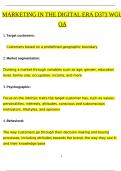MARKETING IN THE DIGITAL ERA D373 WGU
OA
1. Target customers:
Customers based on a predefined geographic boundary
2. Market segmentation:
Dividing a market through variables such as age, gender, education
level, family size, occupation, income, and more
3. Psychographic:
Focus on the intrinsic traits the target customer has, such as values,
personalities, interests, attitudes, conscious and subconscious
motivators, lifestyles, and opinions
4. Behavioral:
The way customers go through their decision making and buying
processes, including attitudes towards the brand, the way they use it,
and their knowledge base
1/
,5. What is marketing?:
The set of institutions and processes for creating, commu- nicating,
delivering, and exchanging offers that have value for customers,
clients, partners, and society
6. Marketing Coordinator:
Entry-level marketing position responsible for planning, executing, and
managing a variety of functions to deliver value to the customer and
the organization (1-3 years).
7. Marketing Director:
Mid-level marketing position responsible for planning, exe- cuting, and
managing a variety of functions to deliver value to the customer and
the organization, with 7-10 years of experience
8. Vice President:
Senior-level marketing position responsible for planning, execut- ing,
and managing a variety of functions to deliver value to the customer
and the organization, with 11-15 years of experience
9. Chief Marketing Officer:
2/
, Top-level marketing position responsible for planning, executing, and
managing a variety of functions to deliver value to the customer and
the organization, with 20+ years of experience
10.Who is responsible for ROI? (return on investments):
Chief marketing officer
11.What is the traditional marketing mix?:
Product, price, place, promotion
12.What is the expanded marketing mix?:
Product, price, place, promotion peo- ple,process, physical evidence
13.Strategy:
Represents what the company intends to do
14.Execution:
Represents how the company intends to do it
3/




